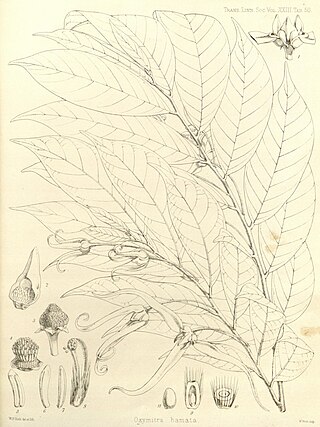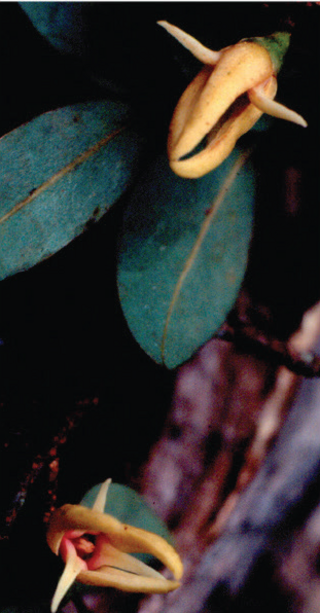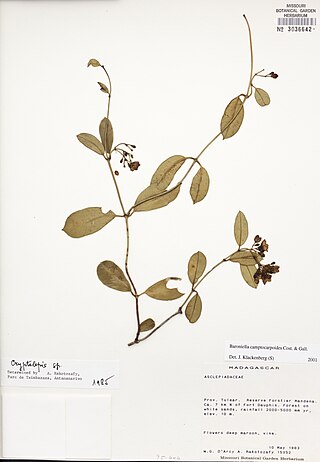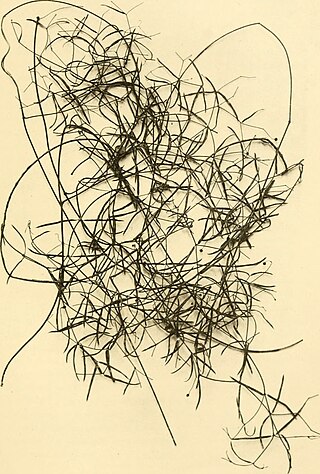
The stamen is the pollen-producing reproductive organ of a flower. Collectively the stamens form the androecium.

Pachypodium brevicaule is a species of plant that belongs to the family Apocynaceae.

Neostenanthera hamata is a species of plant in the family Annonaceae. It is found in Ivory Coast, Ghana, Liberia, and Sierra Leone. George Bentham, the English botanist who first formally described the species, using the basionym Oxymitra hamata, did not explicitly explain the specific epithet, but it has distinctive outer petals with hooked tips.
Annona angustifolia is a species of plant in the Annonaceae family. It is native to Brazil. Jacques Huber, the Swiss-Brazilian botanist who first formally described the species, named it after its narrow leaves.

Annona crassivenia is a species of plant in the family Annonaceae. It is native to Cuba. William Edwin Safford, the American botanist who first formally described the species, named it after the thick tertiary veins that interconnect the secondary veins of its leaves.
Goniothalamus latestigma is a species of plant in the family Annonaceae. It is native to Myanmar and Thailand. Cecil Ernest Claude Fischer, the botanist who first formally described the species, named it after its broad stigmas.
Goniothalamus sawtehii is a species of plant in the family Annonaceae. It is native to Myanmar and Thailand. Cecil Ernest Claude Fischer the botanists who first formally described the species, named it in honor of Maung Saw Teh, a plant collector who provided the specimen examined by Fischer.
Goniothalamus tavoyensis is a species of plant in the family Annonaceae. It is native to Myanmar and Thailand. Debabarta Chatterjee, who first formally described the species, named it after a town in Myanmar that at the time was called Tavoy, but has since be renamed Dawei.
Hexalobus bussei is a species of plant in the family Annonaceae. It is native to Cameroon. Ludwig Diels, the German botanist who first formally described the species, named it after another German botanist, Walter Busse, who collected the sample that Diels examined.
Asteranthe lutea is a species of plant in the genus Asteranthe. It is native to Tanzania. Kaj Borge Vollesen, the botanist who first formally described the species in 1980, named it after its yellow petals.
Duckeanthus is a genus of plant in the family Annonaceae. It is native to Brazil. It contains a single species, Duckeanthus grandiflorus. Robert Elias Fries, the Swedish botanist who first formally described it, named it in honor of Adolpho Ducke who collected the specimen he examined, and its large flowers.
Pseuduvaria mulgraveana is a species of plant in the family Annonaceae. It is native to Australia. L.W. Jessup, the botanist who first formally described the species, named it after the Mulgrave River in Goldsborough, Queensland where the specimen he examined was collected.
Annona quinduensis is a species of plant in the Annonaceae family. It is native to Colombia and Ecuador. Carl Sigismund Kunth, the botanists who first formally described the species, named it after Quindío, a department of Colombia, where the specimen he examined was collected.

Xylopia arenaria is a species of plant in the Annonaceae family. It is native to Kenya, and Tanzania. Adolf Engler, the botanist who first formally described the species, named it after its growth in sandy places.
Xylopia calophylla is a species of plant in the Annonaceae family. It is native to Bolivia, Brazil, Colombia, Ecuador, Peru and Venezuela. Robert Elias Fries, the botanist who first formally described the species, named it after its beautiful leaves.

Apocynum pictum is a species of plant in the Apocynaceae family. It is native to China, Kazakhstan, Kyrgyzstan, Mongolia, and Tajikistan. Alexander von Schrenk, the naturalist who first formally described the species, named it after colored flowers.

Baroniella camptocarpoides is a species of plant in the Apocynaceae family. It is endemic to Madagascar. Julien Noël Costantin and Ernest-Isidore Gallaud, the botanists who first formally described the species, named it after its resemblance to, but distinctiveness from, plants in the genus Camptocarpus.

Baroniella linearis is a species of plant in the Apocynaceae family. It is endemic to Madagascar. Pierre Choux, the botanist who first formally described the species using the synonym Baseonema lineare, named it after its narrow leaves.

Batesanthus pseudopalpus is a species of plant in the Apocynaceae family. It is native to the Republic of the Congo and Gabon. Hendrik J. T. Venter and Rudolf L. Verhoeven, the botanists who first formally described the species, named it after the lobes of its corona which they said resemble the pedipalps of the rain spiders Palystes castaneus and Palystes superciliosus.

Batesanthus purpureus is a species of plant in the Apocynaceae family. It is native to the Cameroon, the Central African Republic, Democratic Republic of the Congo, Gabon, Guinea, Ivory Coast, Liberia, and Nigeria. Nicholas Edward Brown, the botanist who first formally described the species, named it after its purple flowers.









